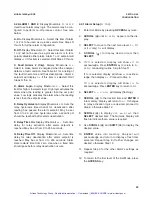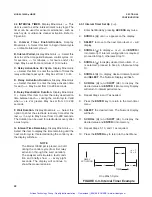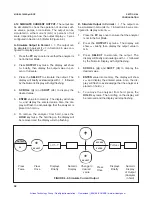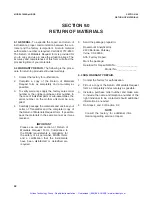
35
MODEL 1054B pH/ORP
SECTION 5.0
START-UP AND CALIBRATION
TABLE 5-1
ORP of Saturated Quinhydrone Solution
(in Millivolts)
pH 4
pH 7
Temperature °C
20
25 30
20 25 30
Millivolt Potential 268 264 260
94 87 80
5.7. STANDARD ORP SOLUTION (1054B ORP
only).
Procedures are given below for making (2)
types of standard ORP solutions with known oxidation
reduction potentials. Either one will be used to cali-
brate the ORP system following the steps at the end of
the section.
CAUTION
The following recipes contain chemical
components that require protective meas-
ures and precautions- Wear protective eye
gear and clothing while working with these
solutions.
A. QUINHYDRONE SOLUTION.
Saturated quinhy-
drone is a commonly used ORP standard solution. It is
made by adding a few crystals of quinhydrone to either
pH 4 or pH 7 buffer. Quinhydrone is only slightly solu-
ble, so a few crystals are all that are needed. The
resulting solution will be yellow-colored. The millivolt
potentials, measured with a clean platinum electrode,
should be within ± 20 millivolts of the values shown.
Solution temperature must be noted to assure accu-
rate interpretation of results. The ORP value of satu-
rated quinhydrone solution is not stable over long peri-
ods of time; therefore, these solutions should be made
up fresh each time they are used.
B. FERRIC-FERROUS AMMONIUM SULFATE
SOLUTION.
This standard ORP solution is not as
easy as the quinhydrone solution to prepare, but is
much more stable and will maintain its millivolt value
for approximately one year when stored in a glass con-
tainer.
To prepare the solution, dissolve 39.2 grams of
reagent grade ferrous ammonium sulfate
[Fe (NH4)2(SO4)2•6H2O]
and 48.2 grams or reagent ferrous ammonium sulfate
[FeNH4(SO4)2•12H2O]
in approximately 700 milliliters of water (distilled water
is preferred, but tap water is acceptable). Slowly and
carefully add 56.2 milliliters of concentrated sulfuric
acid. Add sufficient water to bring the total solution
volume up to 1000 milliliters.
This solution (ferric-ferrous ammonium sulfate) will
produce a nominal ORP of 476 ± 20 mV at 25°C when
used with a saturated KCl/AgCl reference electrode
and a platinum measuring electrode. Some variance in
mV values is to be expected due to the large liquid ref-
erence junction potentials which can arise when meas-
uring this strongly acidic (and concentrated) solution.
However, if the measuring electrodes are kept clean
calibrations can be achieved.
Artisan Technology Group - Quality Instrumentation ... Guaranteed | (888) 88-SOURCE | www.artisantg.com



























